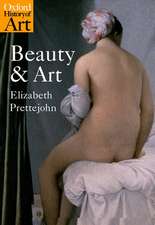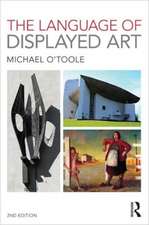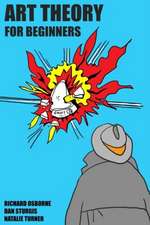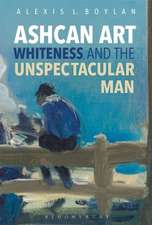Matisse’s Poets: Critical Performance in the Artist’s Book
Autor Dr. Kathryn Brownen Limba Engleză Paperback – 20 mar 2019
| Toate formatele și edițiile | Preț | Express |
|---|---|---|
| Paperback (1) | 234.47 lei 6-8 săpt. | +89.99 lei 7-13 zile |
| Bloomsbury Publishing – 20 mar 2019 | 234.47 lei 6-8 săpt. | +89.99 lei 7-13 zile |
| Hardback (1) | 840.49 lei 3-5 săpt. | |
| Bloomsbury Publishing – 20 sep 2017 | 840.49 lei 3-5 săpt. |
Preț: 234.47 lei
Preț vechi: 299.00 lei
-22% Nou
Puncte Express: 352
Preț estimativ în valută:
44.86€ • 46.84$ • 37.13£
44.86€ • 46.84$ • 37.13£
Carte tipărită la comandă
Livrare economică 05-19 aprilie
Livrare express 01-07 martie pentru 99.98 lei
Preluare comenzi: 021 569.72.76
Specificații
ISBN-13: 9781501351396
ISBN-10: 1501351397
Pagini: 392
Ilustrații: 8 colour and 82 bw illus
Dimensiuni: 152 x 229 x 27 mm
Greutate: 0.53 kg
Editura: Bloomsbury Publishing
Colecția Bloomsbury Visual Arts
Locul publicării:New York, United States
ISBN-10: 1501351397
Pagini: 392
Ilustrații: 8 colour and 82 bw illus
Dimensiuni: 152 x 229 x 27 mm
Greutate: 0.53 kg
Editura: Bloomsbury Publishing
Colecția Bloomsbury Visual Arts
Locul publicării:New York, United States
Caracteristici
The book fills an important gap in Matisse scholarship by examining closely Matisse's relationship to the writers of his generation and showing how the act of reading influenced his development as a painter
Notă biografică
Kathryn Brown is Lecturer in Art History at Loughborough University, UK. She is the author of Women Readers in French Painting 1870-1890 (2012).
Cuprins
List of IllustrationsAcknowledgementsIntroductionMatisse and the BookPerforming Literary CriticismTheorizing Arts of the Book: Maupassant's Influence1. Matisse Among the PoetsModernist GenealogiesControversial Beginnings: The Two Versions of Les Jockeys camouflésEssential LinesThresholds2. 'Visual Thoughts': Les Poésies de Stéphane MallarméArts of EliminationMirrored SpacePoetic Others3. Disowning UlyssesHomeric FrameworksBooks within BooksInnovation, Instability, and TraditionThe Limited Editions Club in a Post-War Art World4. The War Book: Pasiphaé, Chant de Minos (Les Crétois)Performing the 'Solar Myth'Heroism, Shame, and the CorridaFrom Myth to Politics5. Imitation and Innovation: Florilège des Amours de RonsardAppeasing the BibliophilesInfluence: A Modernist RenaissanceObjectification and Identification: Portraying the Female Nude6. Enacting Beauty: Les Fleurs du malA New Architecture for Les Fleurs du malModernism and BeautyMatisse Alone: 'Les Fleurs du bien'7. Problematizing Authorship: Les Lettres portugaisesRectificatory Justice and the BookSelfhood: Matisse's Essays on Art8. Beyond the 'Ritual Space' of the Book: JazzDrawing Words/Hearing ColourThe Failure of Icarus9. Old Acquaintances, New Collaborations: Tzara and ReverdySpontaneityRedefining Ekphrasis: Visages10. Imprisonment and Occupation: Poèmes de Charles d'OrléansA Modernist Illuminated ManuscriptIllustration and ImitationAppropriating Artistic Gesture11. Apollinaire ReduxFriendship as an Interpretive FrameworkThe Book as PortraitWomen and Books: From Apollinaire to Repli12. Literary Legacies Books out of Time TracesBibliographyIndex
Recenzii
This beautiful book will become both a reference work on Matisse's works and a reflection on the critical function of the dialogue of images and text.
It is [...] extremely rare to find a scholar able to move so expertly between literary and visual analysis, and this remains a tremendously impressive and useful contribution to scholarship on Matisse and his literary and artistic networks, on bibliophile culture, and on text-image relationships.
Kathryn Brown here explores all aspects of Matisse's achievements as a book artist, showing how his engagement with writers became a driving force in his aesthetic development. Moving between visual and literary imperatives, she also provides an informed and subtle presentation of the historical context in which Matisse was working, further enriching our appreciation of the books he designed, particularly during and after the second World War, when he combined drawings, cut-outs and poetry to express a spirit of resolute resistance and resilient cultural identity.
Henri Matisse hails from the distinctly French tradition of the painter-poet whose creative output (as well as personal and professional life) was inextricably linked with literature and writers. In Kathryn Brown's clear-eyed and discerning study Matisse's Poets, the artist's collaborative book ventures serve as a fascinating lens through which to examine Matisse's relationship to literature and writers. Using the metaphor of the stage, Brown defines Matisse's artists' books as an effective space where the painter could perform his role not only as illustrator but also as reader, critic, and artist acutely aware of his public image. As such, each chapter in this well-researched and amply illustrated study shows how Matisse self-consciously engaged with literary works by authors as diverse as Stéphane Mallarmé, Henry de Montherlant, Charles Baudelaire, Pierre de Ronsard, James Joyce, Tristan Tzara, among others, to produce and extend his own pictorial language as well as to position himself as a sophisticated reader of both the literary canon and the avant-garde. Brown therefore rightly places Matisse's artists' books within a broad matrix of concerns that allows her to go beyond conventional text-image analyses to include the social and political valences of Matisse's creative and strategic decisions in his diverse publishing projects. The interdisciplinary framework of Matisse's Poets will attract literary critics as well as art historians and scholars of media and book history. Its lucid prose and finely tuned arguments will make it a useful tool for teaching as well as scholarly research.
This is a remarkable book ... [with] a wide range of new aspects and dimensions.
It is [...] extremely rare to find a scholar able to move so expertly between literary and visual analysis, and this remains a tremendously impressive and useful contribution to scholarship on Matisse and his literary and artistic networks, on bibliophile culture, and on text-image relationships.
Kathryn Brown here explores all aspects of Matisse's achievements as a book artist, showing how his engagement with writers became a driving force in his aesthetic development. Moving between visual and literary imperatives, she also provides an informed and subtle presentation of the historical context in which Matisse was working, further enriching our appreciation of the books he designed, particularly during and after the second World War, when he combined drawings, cut-outs and poetry to express a spirit of resolute resistance and resilient cultural identity.
Henri Matisse hails from the distinctly French tradition of the painter-poet whose creative output (as well as personal and professional life) was inextricably linked with literature and writers. In Kathryn Brown's clear-eyed and discerning study Matisse's Poets, the artist's collaborative book ventures serve as a fascinating lens through which to examine Matisse's relationship to literature and writers. Using the metaphor of the stage, Brown defines Matisse's artists' books as an effective space where the painter could perform his role not only as illustrator but also as reader, critic, and artist acutely aware of his public image. As such, each chapter in this well-researched and amply illustrated study shows how Matisse self-consciously engaged with literary works by authors as diverse as Stéphane Mallarmé, Henry de Montherlant, Charles Baudelaire, Pierre de Ronsard, James Joyce, Tristan Tzara, among others, to produce and extend his own pictorial language as well as to position himself as a sophisticated reader of both the literary canon and the avant-garde. Brown therefore rightly places Matisse's artists' books within a broad matrix of concerns that allows her to go beyond conventional text-image analyses to include the social and political valences of Matisse's creative and strategic decisions in his diverse publishing projects. The interdisciplinary framework of Matisse's Poets will attract literary critics as well as art historians and scholars of media and book history. Its lucid prose and finely tuned arguments will make it a useful tool for teaching as well as scholarly research.
This is a remarkable book ... [with] a wide range of new aspects and dimensions.



















